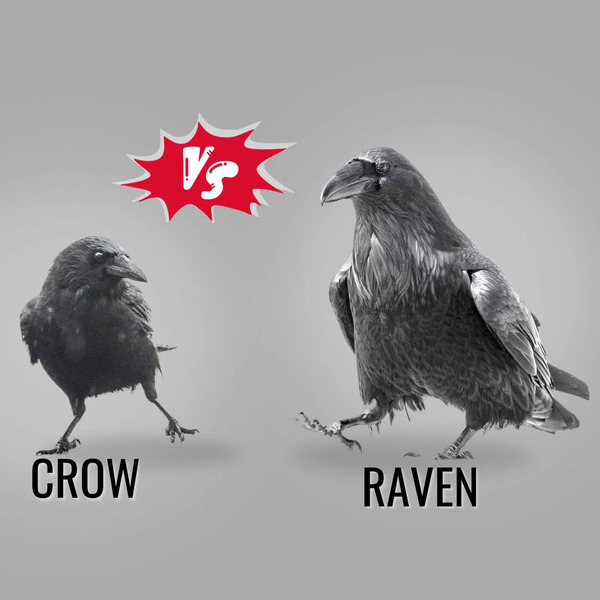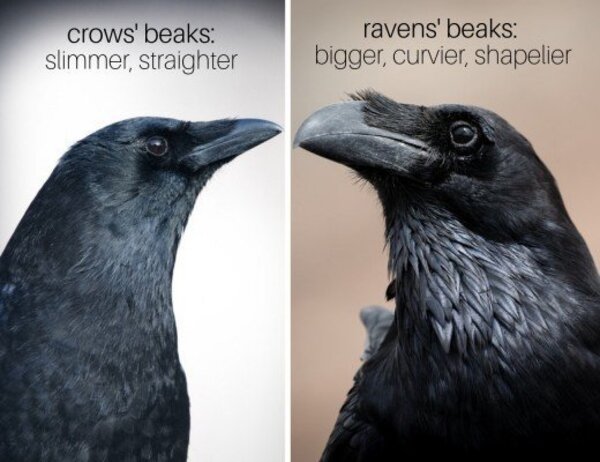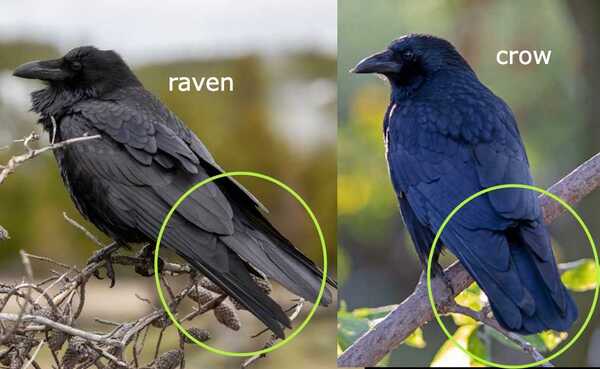When it comes to black-feathered birds, two common names come up: crows and ravens. These birds often get confused for each other due to their similar appearance and behaviors, but they are actually distinct species with unique characteristics. In this article, we’ll break down the differences between crows and ravens, covering everything from their physical traits to their behavior, habitat, and symbolism.

While crows and ravens look very similar at first glance, there are a few key ways to tell them apart.
| Feature | Crow | Raven |
|---|---|---|
| Size | Medium-sized, about 17 inches | Larger, can be over 24 inches |
| Beak | Smaller, thin, pointed | Larger, thick, curved or “roman” |
| Tail Shape | Fan-shaped tail when in flight | Wedge or diamond-shaped tail |
| Neck Feathers | Smooth, sleek | Fluffy, “ruffed” throat feathers |
One of the most noticeable differences is their size: ravens are significantly larger, sometimes even mistaken for hawks when seen from afar. They also have a thicker, curved beak, giving them a powerful, rugged look. Meanwhile, crows are generally sleeker, with more delicate features, and a straight beak.
Both crows and ravens are known for their distinct sounds, which is often how birdwatchers can tell them apart.
Crows: Known for their iconic “caw-caw” call, which is usually loud, sharp, and repetitive.
Ravens: Have a deeper, more guttural “croak” or “gronk” sound, which can sound haunting and resonates at a lower pitch.
Crows tend to be chattier and may call frequently, especially when they’re in groups. Ravens, on the other hand, use a variety of vocalizations but aren’t as noisy as crows.
Crows are incredibly adaptable and can thrive in diverse environments, from urban areas to forests, farmlands, and even mountains. They’re found almost everywhere around the world except for the polar regions and some isolated islands.
Ravens prefer more remote or less urbanized environments. They tend to stick to open landscapes like mountains, deserts, and woodlands, but you may still find them in larger cities occasionally. Ravens are more commonly seen in Northern Hemisphere regions, especially in North America, Europe, and Asia.
Both birds belong to the corvid family, which is known for its intelligence, but their social behavior differs:
Crows: Highly social and are often found in large groups known as “murders.” They are cooperative, often sharing food and working together to protect their territory.
Ravens: Less social and more likely to be seen in pairs or alone. They are known for forming strong pair bonds, and mated pairs usually stay together for life.
Both crows and ravens are incredibly intelligent and have been observed using tools, solving puzzles, and even holding grudges against humans who have wronged them. Crows are known for their ability to recognize faces, communicate with one another, and have complex social dynamics within their groups. Ravens display problem-solving skills and creativity, with some studies showing their ability to create toys or play by sliding down snowy hills for fun.
Crows and ravens are omnivorous and scavengers, meaning they’ll eat just about anything available. However, they have some preferences:
Crows: Often eat insects, seeds, small animals, and even human food waste in urban areas.
Ravens: Tend to prefer meat more, often scavenging on animal carcasses. In the wild, ravens are more likely to hunt for small mammals and birds.
Both birds play an important role in the ecosystem by cleaning up waste and carcasses, but ravens are especially effective at removing carrion from natural environments.
Crows and ravens have a deep place in human culture, mythology, and symbolism.
Crows: In many cultures, crows are seen as tricksters and symbols of intelligence and adaptability. However, in some Western cultures, they have been linked to bad luck, death, and mystery. They are frequently featured in folklore as cunning animals that help or trick humans.
Ravens: Ravens are often seen as mystical and wise figures in folklore. In Norse mythology, the god Odin kept two ravens named Huginn and Muninn, who symbolized thought and memory. Ravens are also seen as symbols of prophecy and protection in various cultures.
Ravens tend to live longer than crows, with some ravens living over 20 years in the wild, while crows typically live between 7-10 years in the wild. Both birds build nests high up in trees or cliffs.
Ravens are known for their elaborate courtship rituals, including acrobatic flights and sharing food with their chosen mate. Crows are also monogamous but generally have simpler mating behaviors.

| Feature | Crow | Raven |
|---|---|---|
| Size | Medium-sized, about 17 inches | Larger, up to 24 inches or more |
| Beak Shape | Thin, pointed | Thick, curved |
| Tail Shape | Fan-shaped | Wedge or diamond-shaped |
| Sound | “Caw-caw” | Deep “croak” |
| Social Behavior | Highly social, lives in groups (murders) | Solitary or in pairs |
| Habitat | Urban, rural, and diverse habitats | Prefers remote areas like mountains or forests |
| Lifespan | 7-10 years in the wild | Up to 20+ years in the wild |
| Symbolism | Trickster, adaptable | Mystic, wise, prophetic |

While crows and ravens are often mistaken for each other, there are numerous ways to tell them apart—from their size and sounds to their social behavior and even their symbolism in different cultures. Whether you spot a clever crow in a city park or a lone raven in a quiet forest, both birds have fascinating characteristics and play vital roles in their respective ecosystems.
animal tags: Crow-Raven
We created this article in conjunction with AI technology, then made sure it was fact-checked and edited by a Animals Top editor.